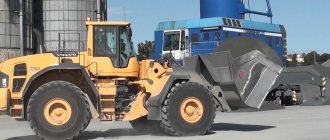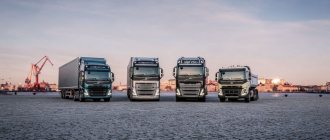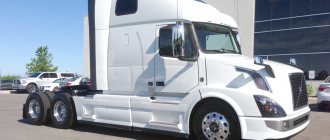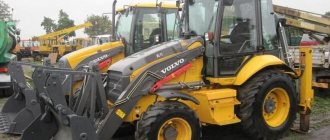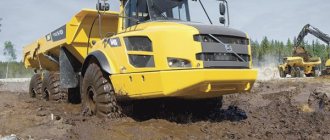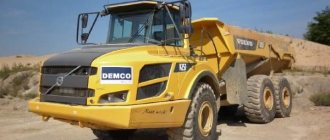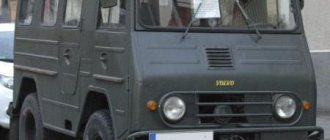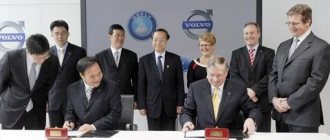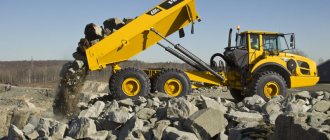Volvo Trucks Corporation
is a Swedish automobile company, one of the world leaders in the production of heavy trucks. Translated from Latin, “volvo” means “I spin” or “I roll.” Belongs to the second largest in the world.
In 2001, Volvo Trucks acquired a controlling stake in Renault's truck division (RVI), which became part of it in 2002 under the name Renault Trucks. The President and Chairman of the Board of Directors is Leif Johansson. The post of chairman of the board is occupied by the former head of Renault, Louis Schweitzer.
History[edit | edit code]
The company was founded in 1916 by Assar Gabrielsson and Gustaf Larson as a subsidiary of the famous bearing manufacturer SKF. In 1927, the first production car leaves the factory gates. Already in 1935, Volvo gained complete independence from SKF.
The first truck appeared in early 1928 - it was the "LV series 1", which was an instant success, and 500 units were sold before the summer [ source not specified 2773 days
]. It had a 2.0 liter 4-cylinder engine with 28 hp. (21 kW).
Activities[edit | edit code]
Volvo produces predominantly (95%) heavy-duty commercial vehicles (in the class of over 16 tons). In terms of production volumes, Volvo Truck Corporation ranks second in the world market [ source not specified 2773 days
].
In 2006, Volvo Trucks sold 105,519 units of trucks [ source not specified 2,773 days
].
Volvo trucks are positioned by the manufacturer as safe and comfortable.
The global international corporation Volvo Trucks Corporation includes design and production centers located in Sweden, Belgium, Brazil and the USA, as well as a large number of assembly plants around the world, in some of which the corporation is represented as a co-founder along with local industrial groups, in others are directly owned by the Volvo Group.
Volvo Trucks, in addition to the brand of the same name, is also the owner of such brands of truck manufacturers as Renault Trucks (Renault Trucks), Mack Truck (American brand) and Nissan Diesel (now UD Trucks).
Volvo Trucks was also at one time a co-owner of the famous truck manufacturer Scania, but in accordance with the decision of the European Union Antimonopoly Committee, it sold its share of shares in this company on the market.
Volvo Trucks has representative offices and service centers in more than 130 countries around the world. Over 1,000 local dealerships around the world and 1,800 technical centers provide truck sales and service.
Volvo Trucks makes almost half of the total sales of its new equipment in Western Europe, and over a third in America. Eastern Europe accounts for 6% of gross sales, but is currently the fastest growing market for Volvo Trucks. In Russia in 2006, 2,436 units of Volvo Trucks heavy-duty equipment were sold [ source not specified 2,773 days
].
In the production structure of Volvo trucks, Volvo FH vehicles have the largest share; in 2006, the manufacturer sold over 40 thousand trucks of this series [ source not specified 2773 days
].
Lighter than the FH series in the current line are Volvo FM series trucks, which are designed for short and medium distance transportation. Delivery trucks are Volvo FL. These trucks are primarily used for quick deliveries within the city and suburbs, removal of household waste and provision of other utility services.
Although Volvo sold its Volvo Car division, the VOLVO Group includes the following divisions[1]:
In 2008, Volvo Trucks sold 105,952 trucks [ source not specified 2,773 days
].
Volvo truck models
For the most common construction and goods transportation, Swedish automakers produce various models of Volvo trucks of the “FM” series. The chassis of the series (with a wheelbase of 3 - 6.7 meters) can be used to mount tilt bodies, vans, dump trucks, and tanks with a body volume of up to 36 cubic meters.
Load capacity, cross-country ability, and other technical characteristics of Volvo trucks depend on the choice of engines. Each model is equipped with three engines with different power ratings.
Diesels of the “FM” series are equipped with four valves for each cylinder and electronically controlled pump injectors. Differences in power allow you to choose between diesel units “D11C” (330 – 450 hp), “D13B” (360 – 440 hp), “D13C” (380 – 500 hp). The power plants are equipped with a manual transmission (9-14 speeds), an I-Shift automatic transmission (12 steps), and a Powertronic automatic transmission (six steps).
Chassis series “FL” (12 – 18 tons) are produced for various bodies of small carrying capacity. They are equipped with a diesel unit with a capacity of 240 - 290 hp.
International activities[edit | edit code]
Cabins are produced in Sweden and Belgium, and engines are manufactured in the central city of Skövde. There are also factories in Sweden (Gothenburg is also the Main Office), Belgium, USA, Brazil, South Africa, Australia, China, India and Russia. The commercial part is divided into 3 divisions - European, North American and International, which covers the rest of the world. Offices and dealers are established all over the world in China, Hong Kong, Taiwan, South Korea.
Volvo Trucks in Russia[edit | edit code]
Volvo Trucks became the first foreign manufacturer to supply a batch of 100 Volvo F89 tractors to the USSR in 1974. The next batch of 150 tractors was received in 1976. The cars served international freight transport in the road transport industry [2].
Today Volvo Trucks is one of the leaders in the Russian commercial transport market. According to statistics, every fourth Western-made truck in Russia is a Volvo [ source not specified 2773 days
].
The total fleet of Volvo trucks in our country exceeds 55,000 units - the best figure among foreign truck brands [ source not specified 2773 days
].
Volvo has the widest network of authorized service stations and sales offices in Russia among foreign manufacturers of commercial vehicles - from Kaliningrad to Vladivostok, and offers its customers a comprehensive transport solution that allows them to optimize service costs and increase business profitability.
Volvo Trucks model range: Volvo FL, Volvo FE, Volvo FM, Volvo FH, Volvo FH16. In 2008, the launch of new models Volvo FM, Volvo FH, Volvo FH16 was successfully launched. In 2010, the new Volvo FMX construction truck and the new Volvo FM regional transport truck were launched worldwide. In the fall of 2010, their production began at the Volvo plant in Kaluga.
The company owns its own Volvo Trucks Centers in St. Petersburg, Moscow and Kaluga. Also, the Volvo Training Center for drivers and mechanics has been operating for over 13 years.
Plant in Kaluga[edit | edit code]
54°28′13″ n.
w. 36°13′45″ E. d.HGЯOL In 2003, Volvo Trucks opened a plant for assembling Volvo trucks in Zelenograd, “VTS-Zelenograd”.[3][4] By 2008, the plant's output exceeded 500 cars per year. Due to the lack of production space, increasing the volume of output was not possible. For this reason, in 2007, at the XII Economic Forum in St. Petersburg, an investment agreement was signed between the management of Volvo and the Kaluga region on the construction of a Volvo plant in the Kaluga-Yug industrial zone. The area of the site is 55 hectares. Investments in the project exceeded 100 million euros. The plant's production capacity is designed to assemble 15,000 trucks per year. After the launch of the plant in Kaluga, the site in Zelenograd was repurposed as a Volvo training center.
On January 19, 2009, the production of trucks was launched at the new Volvo plant in Kaluga.[5] In May 2009, the Ministry of Industry and Trade of the Russian Federation officially assigned the products of Volvo Vostok CJSC the status of domestic products. In 2014, the plant launched a workshop for welding and painting cabins.[6] By the 10th anniversary of the plant in 2022, 31,727 units of equipment were produced. Including 4,665 cars in 2022, and 5,637 cars in 2018.
At the same site there is a workshop for the assembly of Renault Trucks.
Some operational and technical information on the FH and VN models in Russian conditions[edit | edit code]
These are European-type models of medium and large tonnage, respectively.
Even though the control is very pleasant, you need to get used to the peculiarities of gear shifting. The lever has 2 dividers and a total of 4 positions. The side divider switches “halves”, the front divider switches rows. Any untimely switching of the front toggle switch threatens to damage the gearbox. The cars are known to drivers for their convenience, but there are still some nuances. For example, absolutely inconvenient deflectors. They are very difficult to customize. Another flaw in the fuses. If you spill any drink on the dashboard, it threatens to damage it.
Truck tractor with bonnet design for the American market.
Built in the traditions of the American design school, when the machine developer himself makes only the frame, cabin and electrical equipment; and purchases the engine, transmission, brakes, most of the attachments and saddle from third-party companies, along with other North American competing manufacturers (Freightliner, Navistar, Paccar). Engines: Volvo
, Cummins (on older models also Caterpillar and Detroit Diesel).
Non-synchronized gearboxes or robots based on them: Eaton-Fuller, ZF-Meritor. Other transmission units are from the same companies or under their control. The remaining units come from a dozen different domestic highly specialized companies. This scheme is explained by the fact that almost 100% of American tractors are custom-made, and therefore are assembled like a kit from parts that are interesting to the customer. FH
models is minimal: windshield and door windows, interior elements.
In the case of using a Volvo
, it has its own North American power supply, exhaust, and urea-free exhaust gas purification system. In Russia, the car has its admirers, and is perhaps the absolute best truck tractor for Russian conditions. A limitation on wide distribution is imposed by the fact that a road train with an American truck tractor cannot enter Europe due to exceeding the European length gauge.
Service centers[edit | edit code]
There are service centers in almost all countries of the world; in Russia alone there are about 10 of them.
North America[edit | edit code]
Expansion into the American market began in 1959, when sales of Volvo Titan, Volvo Viking and Volvo Starke bonneted tractors began.
Volvo USA's tractor tradition dates back to 1981, when Volvo AB acquired part of American automaker White Motor Corp., creating a joint venture, Volvo White Truck Corp., based in Greensboro, North Carolina.
In 1988, the Volvo GM Heavy Truck Corp. division was created, which began to use joint developments of General Motors (GM) and Volvo in the construction of Volvo trucks and tractors. In 1997, Volvo acquired all General Motors shares in the joint venture and renamed the company Volvo Trucks North America, the North American full-fledged division of Volvo.
In 2001, Volvo Trucks North America emerges from the general Volvo AB brand and takes a special position. Now this company is the world's second largest manufacturer of long-haul tractors and a leader in the development of diesel engines for heavy trucks.
Export markets and countries of production[edit | edit code]
Volvo Trucks are sold in the markets of almost all countries of the world with the exception of China, Japan and several other countries.
Besides Sweden, full or partial production is located in Italy, Russia, USA, Brazil and several other countries.
Models produced in the past[edit | edit code]
1920s[edit | edit code]
1930s[edit | edit code]
- LV66-s and LV68-s
- LV71-s and LV73-s
- LV75
- LV76 - LV79
- LV8 and LV9
- LV18, LV19 and LV29
- "Sharpnose"
- TVA and TVB
1940s[edit | edit code]
- "Roundnose"
- LV11
- TVC
- LV15 and LV24
- L29C and V
1950s[edit | edit code]
- L34
- L39 and L49
- L38 and Viking L48
- TL11, TL12 and TL22
- L36 and L37
- TL31
- L42 and L43
1960s[edit | edit code]
1970s[edit | edit code]
- F89 and G89
- F82S and F83S
- N7, N10 and N12
- C3
- F4 and F6
- F10 and F12
- F6S
- F7
- Traveler
1980s[edit | edit code]
1990s[edit | edit code]
2000s[edit | edit code]
“Swedes” with a tablet: updated Volvo trucks presented in Russia
They have been waiting for the promised for a long time: Volvo Trucks announced the debut of a range of updated trucks more than a year ago, but then the coronavirus struck and all presentations were cancelled. By the way, partly for this reason, the new generation Volvo lost first place to MAN in last year’s international Truck of the Year competition, where Russia is represented by our publication: jury members cannot vote for a model if they have not met it! Nevertheless, at the end of the year, displays for clients began, including in our country: in the fall and winter, such trucks traveled from Moscow to Vladivostok with stops in 24 cities. The time has finally come for their official Russian debut, as production begins at the Kaluga plant in May. So what's new here?
On the outside, first of all, there are headlights, optionally LED and with adaptive high beam (it turns off when oncoming traffic appears). In the cockpit there is a fully digital instrument panel (which even displays road signs) and a tablet to the right of the driver: among other things, detailed information about the trip can be displayed on it.
To the right of the driver is a nine-inch Android tablet
Here, including when the turn signal is turned on, a picture from the video camera in the right mirror bracket is displayed: when the camera is on, the car will not sneak up unnoticed! This is just one of the new driver assistants: there is adaptive cruise control, which can now work in traffic jams, auto braking, and lane control.
The “robot” box has a more massive joystick (it is still located to the right of the seat) and new modes that are switched with a button. The engines were upgraded back in 2019: it is stated that this gives 2-3% fuel savings.
Budget tractors FM and “builders” FMX received a more spacious cabin, unified with the FH series: the overall width of such a cabin is a decent 2.5 m, and the sleeping shelf is located so that you no longer have to sit on it “with your knees near your ears.”
In turn, the FMX dump truck now has a bogie with a load capacity of 38 tons at the rear, not 32 tons as before - in combination with reinforced front springs (four leaves instead of three), this has increased the load capacity. Also for FMX, axles without final drives are now offered - they are lighter than traditional ones, more economical and allow you to work with road trains with a gross weight of up to 100 tons.
The lattice pattern, similar to a whalebone, is called a “waterfall” by Volvo workers
The flagship FH16 with a 16-liter engine now stands out with a shiny grille, and the most spacious XXL version has also arrived. Its cabin is 25 cm longer than that of the XL, and the width of the berth is one meter, like the bonneted “Americans”.
Of course, there are a lot of options for car designs, but here Volvo traditionally focuses on package offers with service contracts - such versions are called FH Vega, FH Neostellar, FM Orbita and FMX Tecton. All of them, we repeat, will be produced at the plant in Kaluga from the 18th week, and 70% of this year’s production volume will be the new generation.
The most popular model is the FH (it accounts for 75% of the brand’s Russian sales), but company representatives hope that the FM will now also be in good demand. They also buy FH16 from us: 60 vehicles have already been ordered.
The official presentation is over, but I still have the documents and keys to two loaded couplings with FH and FM tractors! Well, about how expert long-distance driver Dmitry Silin and I drove these road trains, what fuel consumption we got and how I spent the night in the new “efashka” - in one of the next issues of the column.
